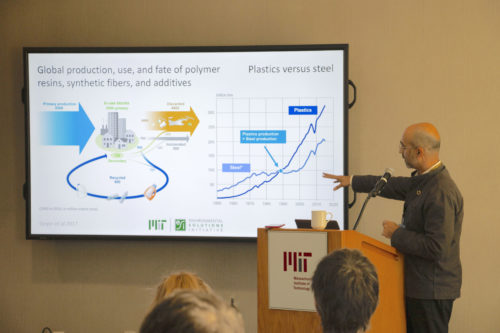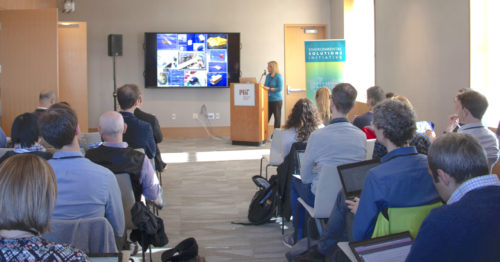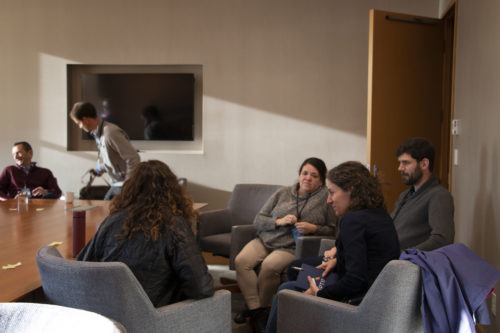Menu
ESI Stories
Inside ESI’s “Modelling Plastics in the Oceans” Workshop
From November 6th to 8th, the Environmental Solutions Initiative hosted a workshop titled “Modelling Plastics in the Oceans: What is happening? What can we do about it?” in partnership with the World Universities Network. Leading researchers from an array of universities, research institutions, and nonprofit organizations, including MIT, the Woods Hole Oceanographic Institution (WHOI), the University of Oxford, and the Rozalia Project, presented their work during five talk sessions held across two and a half days at the MIT Samberg Conference Center. The workshop, part of ESI’s Plastics and the Environment Program, was organized to “share the latest techniques and results that can advance our understanding of the diffusion and degradation pathways of plastics in rivers and oceans” and to “bring the academic, corporate and public-sector communities together for dialogue on this important topic,” said Christopher Noble, ESI’s Director of Corporate Engagement.

ESI Director John Fernandez Introduces the Modelling Plastics in the Oceans Workshop
ESI’s Plastics and the Environment Program was developed last year at a kickoff workshop on microplastics and microfibers, hosted by ESI and the MIT Office of Corporate Relations. “Modelling Plastics in the Oceans” was the first follow-on workshop to emerge from the program, and continued to focus on the problem of microplastics, or tiny, usually degraded pieces of plastic ranging from a few nanometers up to five millimeters in size. A major topic of discussion was the challenge of accurately sensing and modelling these microplastics in real-world settings, a critical first step in understanding the extent of the world’s plastic pollution problem and predicting what kinds of solutions will have the greatest impact.
Microplastics present some unique difficulties for modellers: they typically originate from larger, broken-down pieces of plastic or from industrial resin pellets, and can be any shape and span a wide range of sizes, all of which affects their physical behavior. Their transportation is also affected by chemical and biological processes, which may differ depending on the type of plastic they originate from, what organisms they interact with, and their exposure to sunlight. While microplastics have been much discussed in the news lately, experts are only just beginning to understand how they behave, what effects they have on ecosystems and on human health, or even how much microplastic is accumulating in the natural world. Research presented at ESI’s “Modelling Plastics in the Oceans” workshop analyzed how microplastics can be detected, how they are transported, and what knowledge gaps must be filled to develop a comprehensive understanding of the problems we are facing.
Researchers at the workshop discussed various methods for detecting microplastics. Scott Gallager, Associate Scientist at WHOI, spoke about the use of Raman spectroscopy to detect, classify and quantify plastics in the ocean. Gallager described the Raman signal as a tool that can be a “very precise fingerprint for a given plastic compound.” In his examination of the Hudson River, he found that most particles were concentrated at the interface of freshwater and saltwater. Gallager is now working on developing a time-stamp for microplastics.
Alternatively, the oldest method for detecting microplastics in the ocean, plankton net towing, continues to yield useful data that can be compared across decades of field experiments. Kara Lavender Law, the workshop’s keynote speaker and an oceanographer at the Sea Education Association and WHOI, described this approach, noting that consecutive plankton net tows in space and time have given widely different values of microplastic concentrations. Many thousands of plankton net tows have been performed globally since the 1970s, and one useful role of modellers is to help explain why tows at different depths or in different oceanic conditions have given such different counts, so future tows can correct for these variables. Law reported that estimates of the total amount of microplastic in the open ocean range from 93,000 all the way to 236,000 metric tons, depending on the model used to correct plankton net tow data.

Keynote Speaker Kara Lavender Law Presents an Overview of Ocean Plastic Transport
Microplastics have infamously been found in seawater, freshwater, drinking water, soil, and a diversity of organisms. Many speakers at the modelling workshop presented their research on the transport and dispersion of microplastics, whether using mathematical models or computer simulations. In Dr. Law’s keynote address, she explained that the materials enter the water through improperly managed waste, shipping, wastewater, fishing, runoff from land, and catastrophic events such as tsunamis. They are then transported by wind, ocean currents, gyres, and waves, but their ultimate destination is still controversial. While models all agree that surface ocean concentrations of microplastic are highest in the subtropics, there is less agreement about other areas of the ocean or how long plastics remain at the ocean surface. Speakers Jake Gebbie and Carol Anne Clayson of WHOI discussed how vertical and horizontal motions in the upper ocean spread microplastics from the sea surface down to miles underwater. From the University of Quebec Rimouski, Daniel Bourgault, Christiane Dufresne, and Sandy Gregorio spoke about transport by internal waves and the accumulation of debris through eddies. Sam Levang of WHOI discussed the notorious plastic “garbage patches” where the heaviest pollution gathers. When plastic is released along coasts, it is transported through ocean currents and, over the course of decades, congregates in centers of gyres―although the idea that these “patches” look like large floating islands, as often portrayed in the news, is a misconception.

During Breakout Sessions, Attendees Discussed Future Collaborations and Research Directions
Major knowledge gaps and challenges still remain for plastics modellers to solve. One aim of the workshop was to improve communication across different fields, and identify areas where cross-disciplinary research could yield new insights. For example, modellers could improve the accuracy of their work if they partner with biologists to understand the details of microplastics consumption by marine organisms. Models could also be informed by plastic degradation studies performed by chemists. A recurring theme of the workshop was the lack of information surrounding how plastics are transformed, and what their ultimate fate is. In her keynote address, Dr. Law raised questions about how long it takes plastic in the ocean to fragment or remineralize, how long it remains on the sea surface, and where it eventually settles and builds up. Collin Ward, Assistant Scientist at WHOI, also emphasized the need for algorithms that include photochemistry in models of plastic degradation and dispersal, as sunlight breaks down certain plastics, like polystyrene, into component elements.
Each day of the workshop included a breakout session where attendees from nonprofit foundations and corporate partners of the Plastics and the Environment Program talked directly with the academic speakers, to encourage the exchange of ideas, build connections, and discuss research possibilities. As ESI develops new workshops and raises funding for plastic pollution research at MIT, these exchanges help seed the ground for future initiatives under the Plastics and the Environment Program. The Program’s next workshop, which will take place in the late spring of 2020, will focus on policy and regulation, with the aim of understanding how new research can inform better plastic waste management at the local, national and international levels.
Contributed by Olivia Burek and Alyssa Farkas, ESI Programs Interns















